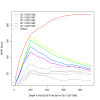ProPhylo: partial phylogenetic profiling to guide protein family construction and assignment of biological process
- PMID: 22070167
- PMCID: PMC3226654
- DOI: 10.1186/1471-2105-12-434
ProPhylo: partial phylogenetic profiling to guide protein family construction and assignment of biological process
Abstract
Background: Phylogenetic profiling is a technique of scoring co-occurrence between a protein family and some other trait, usually another protein family, across a set of taxonomic groups. In spite of several refinements in recent years, the technique still invites significant improvement. To be its most effective, a phylogenetic profiling algorithm must be able to examine co-occurrences among protein families whose boundaries are uncertain within large homologous protein superfamilies.
Results: Partial Phylogenetic Profiling (PPP) is an iterative algorithm that scores a given taxonomic profile against the taxonomic distribution of families for all proteins in a genome. The method works through optimizing the boundary of each protein family, rather than by relying on prebuilt protein families or fixed sequence similarity thresholds. Double Partial Phylogenetic Profiling (DPPP) is a related procedure that begins with a single sequence and searches for optimal granularities for its surrounding protein family in order to generate the best query profiles for PPP. We present ProPhylo, a high-performance software package for phylogenetic profiling studies through creating individually optimized protein family boundaries. ProPhylo provides precomputed databases for immediate use and tools for manipulating the taxonomic profiles used as queries.
Conclusion: ProPhylo results show universal markers of methanogenesis, a new DNA phosphorothioation-dependent restriction enzyme, and efficacy in guiding protein family construction. The software and the associated databases are freely available under the open source Perl Artistic License from ftp://ftp.jcvi.org/pub/data/ppp/.
Figures





References
-
- Gaasterland T, Ragan MA. Microbial genescapes: phyletic and functional patterns of ORF distribution among prokaryotes. Microb Comp Genomics. 1998;3:199–217. - PubMed
Publication types
MeSH terms
Substances
Grants and funding
LinkOut - more resources
Full Text Sources
Molecular Biology Databases

